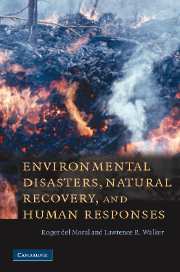Book contents
- Frontmatter
- Contents
- Preface and acknowledgements
- 1 Introduction: a crescendo of destruction
- 2 Natural disturbances: synergistic interactions with humans
- 3 Infertile and unstable habitats
- 4 Infertile and stable habitats
- 5 Fertile and unstable habitats
- 6 Fertile and stable habitats
- 7 The lessons learned
- Glossary
- Illustration credits
- Index
- Plate section
- References
4 - Infertile and stable habitats
Published online by Cambridge University Press: 11 September 2009
- Frontmatter
- Contents
- Preface and acknowledgements
- 1 Introduction: a crescendo of destruction
- 2 Natural disturbances: synergistic interactions with humans
- 3 Infertile and unstable habitats
- 4 Infertile and stable habitats
- 5 Fertile and unstable habitats
- 6 Fertile and stable habitats
- 7 The lessons learned
- Glossary
- Illustration credits
- Index
- Plate section
- References
Summary
STABLE HABITATS DEVELOP SLOWLY
Hard rock surfaces abound in nature, but they eventually develop a cover of vegetation. External forces soon begin to alter them by increasing their permeability to water and susceptibility to erosion. Even the slightest roughness or a small crack will allow plants to colonize such hard surfaces. Surface heterogeneity is caused by rapid temperature changes or by differential erosion of rock minerals. Most of these surfaces are created by lava (from Italian, labes, a falling, coined by Francesco Serao upon observing Vesuvius erupting in 1737), but steady erosion can also expose other types of rocks over time. Abrupt exposure of rock surfaces comes from sudden events such as landslides. Although hard surfaces are infertile, their stability allows slow-growing lichens to establish in dry habitats and mosses in wetter habitats. Cracks allow long-rooted woody plants, like trees, to gain a foothold. If successful, these large plants soon dominate exposed rocky surfaces, covering them with their dead leaves and accelerating the process of soil development and successional change in plant composition. On gentle terrain, succession may be slow, but it is inexorable. On steep slopes, gravity chronically removes nascent plant life, exposing new, abiotic surfaces. How plants cope with such stresses in natural habitats provides unique lessons for rehabilitation of analogous habitats caused by humans such as abandoned roads, parking lots and industrial rubble, quarries and walls. In this chapter, we will discuss two very different kinds of hard surfaces: lava and cliffs.
- Type
- Chapter
- Information
- Publisher: Cambridge University PressPrint publication year: 2007



